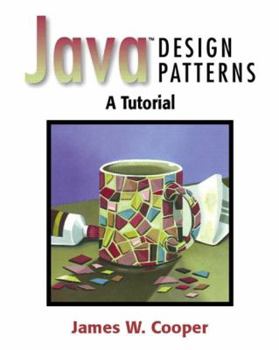Java? Design Patterns: A Tutorial
Design patterns have become a staple of object-oriented design and programming by providing elegant, easy-to-reuse, and maintainable solutions to commonly encountered programming challenges. However,... This description may be from another edition of this product.
Format:Paperback
Language:English
ISBN:0201485397
ISBN13:9780201485394
Release Date:February 2000
Publisher:Addison-Wesley Professional
Length:352 Pages
Weight:1.15 lbs.
Dimensions:0.7" x 7.3" x 9.2"
Customer Reviews
5 ratings
The best, so far...
Published by Thriftbooks.com User , 23 years ago
Yes, the book does have some `funky' examples for which we need other examples (i.e. swimming) to understand. I have read most of the patterns books and this one is by far the clearest and best written. The author uses example code with GUI components, which helps the reader bridge the gap between the abstract and the concrete. I don't mind the typos since I consider them an integral part of the learning process. I also take in consideration the fact that no product, book...is ever going to be perfect. But again, typos are an aberration to any beginner trying to `swim' through the murky waters of a new language or concept. Learning patterns tend to be a difficult task. The frustration of many people will show in the low rating they give most of the patterns books. To measure the return on investment of a book is to know whether a book has advanced my knowledge and thus added real value to the software I write. In this case, it is a resounding yes. The Gang of Four book (GOF) is `the pattern book'. Problem is, there are no examples, unless you have C/C++ background, which I don't have. I admit that GOF is the best-written patterns book, but the lack of good examples makes it almost useless. Cooper has an excellent column in JavaPro magazine called JavaTecture in which he writes about design patterns, different Java technologies, and coding tips and techniques. Thankfully, his work for the magazine is well edited and is just one of many tools I use to expand my Java knowledge.
Good pattern book
Published by Thriftbooks.com User , 23 years ago
If you have read the GOF pattern book and need to translate all the good ideas from the book to Java, this is the book for you. The author manages to give good examples of all the patterns, the code works just fine. There is a good reference at the end of the book that explaines the patterns in the swing libraries. To summarize, this is a really good book. However, if you are new to programming you shouln't read pattern books yet. Do some programming first and then read pattern books!/Cheers
Great way to understand patterns on the first reading
Published by Thriftbooks.com User , 24 years ago
The authors of the landmark book "Design Patterns" book by Erich Gamma...[et al.] aka the Gang of Four (GOF) book state in their preface: "Don't worry if you don't understand this book completely on the first reading. We didn't understand it all on the first writing!"Cooper's "Java Design Patterns A Tutorial" is so clearly written that the reader can quickly understand the main idea of a pattern and how to implement it on the first reading. Cooper recommends in his introduction that you also read the Gof Design Patterns book. This really makes a powerful combination. First read about a pattern in Cooper's book so that you know what the key parts to it are and what you need to do to code it. Then study the gof book and ponder the insights of the masters. I have another book on Patterns in Java but I find that book harder to understand than the Gof book. Only after reading about a pattern in Cooper's book could I go back to the other book and understand the presentation of the pattern. Basically, you are left thinking "nice code but how do I apply this to my own work? what do I really need to do to implement this pattern?" Cooper's book clears all that up. Cooper is like the good friend in college who could explain something to you in 10 minutes that you couldn't understand after an hour lecture or hours of studying. Java Design Patterns a Tutorial by James Cooper is one of the best books I have.
Clear writing and provides good basic understanding of GOF
Published by Thriftbooks.com User , 24 years ago
Cooper is a very clear writer and provides down to earth explanations for each pattern as well as complete Java/Swing examples. I would compare Cooper's writing with Mark Watson for clarity, and have recommended this book to many programmers, especially those relatively new to object oriented concepts.
Great basic introduction
Published by Thriftbooks.com User , 24 years ago
This book provides an easy introduction to design patterns. The book moves easily from subject to subject and the material covered is refreshing and novel. Too many Java books do nothing to illuminate important design concepts but simply rehash well-worn concepts, i.e. what is an object, encapsulation, inheritance, polymorphism, etc. This book provides an excellent introduction to design patterns, an important tool in the lexicon of programmers, through good prose and concise examples that highlight the similarities and differences of the various patterns.





